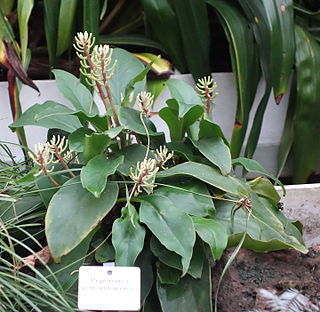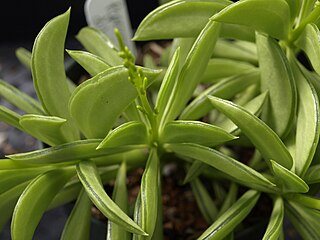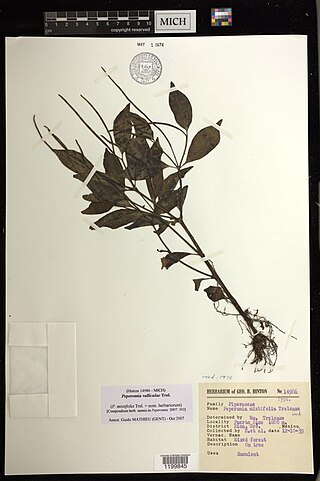
Peperomia is one of the two large genera of the family Piperaceae. It is estimated that there are at least over 1,000 species, occurring in all tropical and subtropical regions of the world. They are concentrated in South and Central America, but may also be found in southern North America, the Caribbean islands, Africa, Oceania, and southern and eastern parts of Asia. The exact number of species is difficult to determine, as some plants have been recorded several times with different names, and new species continue to be discovered. Peperomias have adapted to many different environments and their appearances vary greatly. Some are epiphytes or lithophytes, and many are xerophytes or possess underground tubers (geophytes). Most species are compact perennial shrubs or vines.

Ceanothus is a genus of about 50–60 species of nitrogen-fixing shrubs and small trees in the buckthorn family (Rhamnaceae). Common names for members of this genus are buckbrush, California lilac, soap bush, or just ceanothus. "Ceanothus" comes from Ancient Greek: κεάνωθος (keanōthos), which was applied by Theophrastus to an Old World plant believed to be Cirsium arvense.

Piper aduncum, the spiked pepper, matico, hierba del soldado, achotlín, cordoncillo, higuillo or higuillo de hoja menuda, is a flowering plant in the family Piperaceae. Like many species in the family, the matico tree has a peppery odor. It grows wild on the coasts and in the forests of Central and South America and in the Interandean Valleys, up to 3,000 m (9,800 ft) above sea level.

Hibbertia scandens, sometimes known by the common names snake vine, climbing guinea flower and golden guinea vine, is a species of flowering plant in the family Dilleniaceae and is endemic to eastern Australia. It is climber or scrambler with lance-shaped or egg-shaped leaves with the narrower end towards the base, and yellow flowers with more than thirty stamens arranged around between three and seven glabrous carpels.

Peperomia pernambucensis is a species of plant in the genus Peperomia in the family Piperaceae. Its native range is in Central and South America from Nicaragua to Bolivia.

Peperomia dolabriformis is a species of plant in the genus Peperomia in the family Piperaceae. The species is also known as prayer pepper. The plant is used as an ornamental houseplant. It is native to Ecuador and Peru.

Peperomia glabella, commonly known as the cypress peperomia or wax privet, is a species of plant in the genus Peperomia of the family Piperaceae. Its native range is from southern North America to central South America. Three varieties are known. In addition to the basic one they are P. glabella var. nudipetiolata and P. glabella var. obtusa (Steyerm.).

Peperomia valliculae is a species of epiphyte and herb from the genus 'Peperomia'. Peperomia valliculae can mostly be found in Central America. It primarily grows in wet tropical biomes.
Peperomia venabulifolia is a species of perennial or herb from the genus Peperomia. It was discovered by William Trelease in 1940.
Peperomia venezueliana is a species of herb and hemiepiphyte subshrub from the genus Peperomia. It grows in wet tropical biomes. It was discovered by Casimir de Candolle in 1866, in Venezuela..
Peperomia vidaliana is a species of herb from the genus Peperomia. It was discovered by William Trelease in 1936. Collected specimens date back to 1876 in Paris. Vidaliana came from the surname "Vidal-Sénège". This refers to the species being collected by M. Vidal-Sénège. Peperomia vidaliana is endemic to Peru. Specimens were collected by M. Vidal-Sénège in 1876–1877.
Peperomia vestita is a species of epiphyte from the genus Peperomia. It was discovered by Casimer de Candolle in 1898.
Peperomia versicolor is a species of epiphyte or lithophyte from the genus Peperomia. It grows in wet tropical biomes. It was discovered by William Trelease and published the species in the book "Contributions from the United States National Herbarium 26(4): 200. 1929". First-ever specimens were founded in Costa Rica and 1926. versicolor means particolored or changes its color.

Peperomia viracochana of plant from the genus Peperomia. It was first described by William Trelease and published in the book "Publications of the Field Museum of Natural History, Botanical Series 13(2): 105. 1936". It is endemic to Cusco, Peru.

Peperomia uncatispica is a species of plant from the genus Peperomia. It was first described by William Trelease and published in the book "Publications of the Field Museum of Natural History, Botanical Series 13(2): 102. 1936.". It primarily grows on wet tropical biomes.

Peperomia tricolor is a species of epiphyte from the genus Peperomia. It was first described by William Trelease and published in the book "Publications of the Field Museum of Natural History, Botanical Series 13(2): 101. 1936 ". It grows on wet tropical biomes. Its etymology came from the green with white nerves, and red black glabrous.

Peperomia talinifolia is a species of hemiepiphytic subshrub in the genus Peperomia. It was first described by Carl Sigismund Kunth and published in the book "Nova Genera et Species Plantarum 1: 62, t. 8. 1815[1816]. ". It primarily grows on subtropical biome.

Peperomia tenelliformis is a species of perennial, lithophyte or epiphyte in the family Piperaceae. It was first described by William Trelease and published in the book "Contributions from the United States National Herbarium 26(4): 203. 1929. ". It primarily grows on wet tropical areas. The species name came from Latin words wikt:tenellus + wikt:forma, which means tender form.













